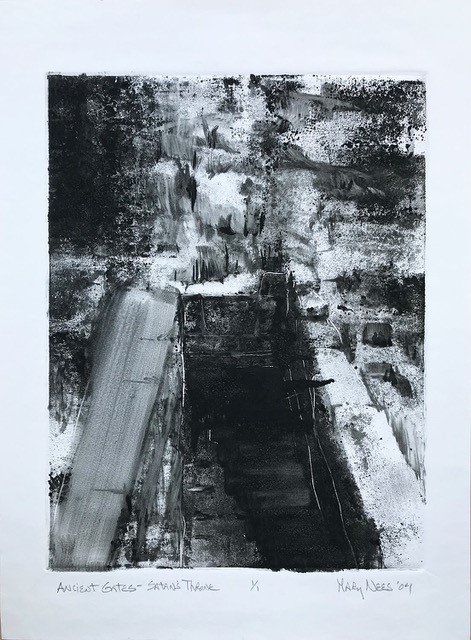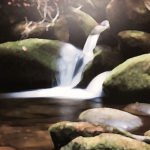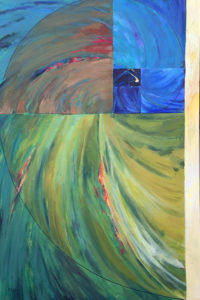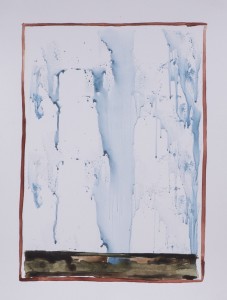How brittle are the Piers
On which our Faith doth tread–
No Bridge below doth totter so–
Yet none hath such a Crowd.
It is as old as God–
Indeed–t’was built by Him–
He sent His son to test the Plank,
And he pronounced it firm.
E.Dickinson, #1433
How brittle are the Piers
On which our Faith doth tread–
No Bridge below doth totter so–
Yet none hath such a Crowd.
It is as old as God–
Indeed–t’was built by Him–
He sent His son to test the Plank,
And he pronounced it firm.
E.Dickinson, #1433
In early morning dark, I was driving my friend to a hospital in another city. We’d been given some pretty clear directions and told it was simple, so off we went. Toward the end of our journey, our eyes focused for the landmarks (in the disruption, neither of us had our “devices”). Ok, we passed the Walgreens where we turn. Ok, we’re supposed to go over this bridge. Ok. . . so where is the next turn, did we miss it? We both leaned forward in our seats, the car ambling forward into the dim. Another couple blocks and we saw a blue hospital sign, then down a hill, around a corner and it felt like maybe we were approaching the right vicinity. Soon: lights, cameras, action.
On the way out, hours later, we retraced our route to get back to the interstate. This part is why I am telling the story: the time to travel out was eons shorter than that long and ponderous earlier drive! How could this be? It was the same exact path of streets we took coming in. But our experience of time was completely different in the reverse direction. We both were startled by this and it got me thinking.
Time seems to be an elastic thing, even as it ticks with a measurable rhythm. Sometimes as I lie in bed at night, I can feel and hear in my ears the beat of my own heart in a predictable rhythm that is beyond my control: pump. pump. pump. I can manipulate some variance in the count of those beats: get excited and they move faster, focus on relaxing and they settle down, but I cannot stop the beats, nor do I want to. Time moves like this in a set program; I cannot ultimately change it’s progress or it’s pace. As I move through time however some things feel quick and some things feel terribly, terribly slow. Certainly the moments looking for the hospital as we examined every sign and longed for every turn were experienced by us as LONG. But on the way out, hearts lifted, day shining and mission accomplished—the entrance to the interstate was so quick it was entirely startling.
Here’s why this informs me: I am awaiting the arrival of Jesus, as He promised. I am moving along looking for His signs. He said the way was simple and just ahead. But it is dim out there where I am traveling now. I will keep going forward. His way is sure. It’s the time thing that has me at the edge of my seat.
So, is it my experience in time, awaiting His arrival that makes it seem LONG? Is it the heartstopping events that make the pace seem to stagger, and the exciting parts make it seem to speed up? This much is clear: time may be subjectively experienced, yet it remains a measured finite resource that moves in one direction only. This video I shot was on a blustery afternoon, also just recently. The movement here reminds me of a phrase in a poem by Susan Morrison, (age 11) “Hours are leaves of life, and I am their gardener, each hour falls down slow.”

Signs in daily life are indicators. I see a red stop sign; I stop within a few feet. Signs give warning as to what’s ahead, and signs give one time to think and still to choose which way to respond. There’s a little bit of time between seeing the sign and getting my foot soundly on the brake. I am glad for that. So are my riders.
Darkness is a sign; a shaded marker that is showing up everywhere now. Look around, listen, watch. I am just articulating what you already know (maybe don’t want to know, but sense just the same). Darkness is a departure from light. It surrounds, entraps and leaves one cold. You don’t want to be there. There is nothing calming in a place of unarticulated blackness.
 Artists work in the arena of making some kind of signs, knowingly or not, coherent or otherwise. All artists are doing representation of some sort, making indicators of something else. For example, even in the arranging of darks and lights, an artist seeks to use these elements toward highlighting some aim. We even talk about “value structure” though we might otherwise insist there is not such a thing as real value indicated at all by our arrangements. Still, handling lights and darks well are basic coins of the realm in visual work. All light in the composition and we are overwhelmed and cannot see. All darkness and there simply is nothing to see. This is basic, and objectively understood.
Artists work in the arena of making some kind of signs, knowingly or not, coherent or otherwise. All artists are doing representation of some sort, making indicators of something else. For example, even in the arranging of darks and lights, an artist seeks to use these elements toward highlighting some aim. We even talk about “value structure” though we might otherwise insist there is not such a thing as real value indicated at all by our arrangements. Still, handling lights and darks well are basic coins of the realm in visual work. All light in the composition and we are overwhelmed and cannot see. All darkness and there simply is nothing to see. This is basic, and objectively understood.
Handling light and darks well in life is another matter all together. I have worked with both. I am also a current events watcher, a Bible reader, and a concerned friend. I’m noting that dark signs are stacking up faster than I have ever seen in my 4 plus decades of following the words of the prophets. There is some heaviness in all this observing, there is also some significant hope. Think about this (recorded by the first prophet Moses): the Creator came first in the Genesis account. He was primal. He was deliberative. He spoke and then light came into a place that was full of darkness. That place is further described in Genesis, 1st chapter, verse 2, as being a deep and formless void. The light entering there was a jail break, a remake. The light came into the darkness and then started staging a re-creation. And that was just in the beginning.
But there’s a problem, revealed in the story of the rest of the book. There is an imitator of light who lies, and we are all vulnerable to him. He was named by Jesus as “the father of lies”, “the serpent of old”. He entrapped the whole human race early, not long after that re-make. He masquerades as light (or as any number of fascinating imitations). He can only imitate; he cannot Create but he is crafty. Even the most earnest seekers of good get sidetracked by his clever luring. He is luring you if you are unawares. His intentions are the opposite of the Creator’s; the imitator’s intentions are not good. Like the pilgrim in Bunyan’s tale, we are too easily blinded by this one who lies.
“This life’s dim windows of the soul
Distorts the heavens from pole to pole
And leads you to believe a lie
When you see with, not through, the eye.”
And here’s a watchword: it doesn’t have to end this way. Inserted here is a video that might help you see more of the grand story. If God is the originator of the story, then there is a story, and it has a valuable end. (If He is not, then ultimately there is no story.)
poem above by William Blake, 1757-1827
image “Ancient Gates/Satan’s Throne”, monotype by Mary Nees

One evening late, near Canada this month, I was walking outside and looked up.
It was startling!
Above me was a tableau sparkling with wonderment. I remember as a child pondering the patterns in the wilderness skies. I had no concrete belief in God then, at least I didn’t until I started looking up.
I remember not too long ago having a probing conversation with a young Navy man. I asked him “have you ever looked up and just wondered about all those star clusters . . ?” The young man looked at me and said, “Ma’am, we can’t see the stars in the ghetto.” I was stopped short. He returned my silence with sadness. He knew he’d stopped my wonder. Poverty is not just material.
When the vacuous haze of our own artificial light is dimmed however, when we can get away to where the simple sky is visible we have opportunity to see so much more. It hangs there for free. It has no boundaries of nation or class. In all the other centuries of history the brilliance was so much more accessible. There are star names from ancient Persian, Chinese, Greek, Coptic, Arabic, Ethiopian, Hebrew and Chaldean observers who studied and followed the patterns.
I so wanted to photograph the night sky this time. I emailed a friend to find out if there could be a way to catch a record with my simple camera. No, she said, “you will just have to burn the sight onto your retina, and then paint it for us!” So I did, I burned it into my memory and in some way, I want to translate it.
The real display is still there. Find some way to look up.
Tell all the Truth but tell it slant—
Success in Circuit lies
Too bright for our infirm Delight
The Truth’s superb surprise
As Lightening to the Children eased
With explanation kind
The Truth must dazzle gradually
Or every man be blind—
Emily Dickinson penned these words in 1868. I believe she was grappling with how to bring important things forward into human awareness. She used what she saw in nature as sign posts for bigger ideas. She was therefore an abstractionist, looking for simple indicators that could tease the way forward for blind men. Reading through her poems I catch her spirit though we live in such different times. She was not didactic, but she was determined.
Yesterday, as I was lying on an exam bed, the scanner moving back and forth above me, my eyes looked to the wall at an image similar to this. Here, like with Emily’s words, is a suggestion that dazzles gradually. Images are “quick talk” without words, and language (we are given to expect, or we are deaf as well) holds meaning.
An artist, explaining her work at an opening, spoke of a biologist whose important research informs her imagery. I was moved by how she described her loss when her scientist friend died; she paused and simply said “. . . so much knowledge. . .gone”. Her sadness wafted into the room, while her work hung behind her carrying the synopsis.
For me, this was a moment of seeing.
This week we learned that another man, with a trove of skill in his head is now also gone. The loss is incalculable. Our friend had unusual gifts in ancient languages and was investing his passion training others in Asia. A motorcycle accident, seeming so random, snuffed out his life. “so much knowledge, so much to give . . .gone.” No one can repeat what this man did. His students will take up what little they caught and try. A few may carry the synopsis.
For me, this is a moment where I am blind again.
How does one measure a life, any life?
This depth of value is so much more than simple breath, or years lived. I remember when I held the lifeless body of an hours-old child. We were pierced through with grief. This little girl had no time to realize embedded skills and passion. We were robbed of her, the whole world was robbed of her, before she could even try.
Death is a cruel thief, snatching intrinsic value we hardly can speak of. This is why tears come. We cannot hold it in, something leaks out, this is too much for us. This pause at grief is where what is seen blinds us to anything beyond. We cannot settle well with what is unseen.
The Psalmist, carrying the same question, blurts several times, “What is man, that you (God) are mindful of him?” (Psalm 8) The writer is wrestling with wonder, at unseen value. “. . .that Thou dost take knowledge of him. . .that Thou dost care for him?” Important men, and unknown men have this value, tiny baby girls hold within them this inestimable value, even though each “is like a mere breath, his days like a passing shadow.” (Psalm 144).
image above: “Notes from the Miocene (turtle)” by Suzanne Stryk, 11″ x 8″, 2007. Used by permission of the artist. See more of her work here>http://www.suzannestryk.com
The Psalms of Ascent are a particular progression found in Psalm 120-134. Sometimes called the Psalms of Degrees, these 15 declarations were memorized and sung as pilgrims stepped their way up to Jerusalem for the festivals appointed earlier by Moses. I am not Jewish. But I have long been interested in these songs and what they reveal to any God-seeker about significant forward movement in any true spiritual journey.
There are patterns here that are fascinating. The 15 have several groupings in a sure progression. There is a rhythm that continues unabated even through the seeming randomness, and in some cases desperateness of human trial that is spoken of in the Psalmist’s language. The imagery is a rich and meaningful minefield. The collection repeatedly speaks to the past, the present and the future. It is actually a recipe for hope, and a picture of the concerns of an enlarging heart.
 What I am posting today image-wise is a little embarrassing. I did this in 2002. It is a rather large piece: 3’x2′, laid down originally with acrylic. I was ambitiously hoping to put into imagery what I see happening in this collection of Psalms, but critiquing my own attempt, this is brash looking, really uninteresting visually, too direct. For these reasons and others this piece sat hidden behind much else for the last 13 years.
What I am posting today image-wise is a little embarrassing. I did this in 2002. It is a rather large piece: 3’x2′, laid down originally with acrylic. I was ambitiously hoping to put into imagery what I see happening in this collection of Psalms, but critiquing my own attempt, this is brash looking, really uninteresting visually, too direct. For these reasons and others this piece sat hidden behind much else for the last 13 years.
Thinking about this progression of ascent again however, and studying the Psalms further, I decided I had to rework this attempt–to go right on top of it. Already the piece here viewed is much different (thank goodness–necessity becomes the mother. . .).
I worked on it all day yesterday and I have much more to do before I will show the finish. It is turning into a subtle landscape. I hope to veil the progression, while also making it more vital, hoping to articulate the wonder in these steps of inner and outer ascending. I am committed to it now.
from Emily (#1221) this morning as I ponder the sad loss of another soul.
Some we see no more, Tenements of Wonder
Occupy to us though perhaps to them
Simpler are the Days than the Supposition
Their removing Manners
Leave us to presume
That oblique belief which we call Conjecture
Grapples with a Theme stubborn as Sublime
Able as the Dust to equip its feature
Adequate as Drums
To enlist the Tomb.
To have a sense of character, one has to spend some time observing and experiencing. We make decisions on character based on what we see, sometimes quickly, sometimes considerably. When someone then does something “out of character,” we state our surprise according to a prior set of expectations, coming out of some kind of history. Shift to the realm of ideas. When it comes to knowing or recognizing what is good and what is truly evil, it seems to me that we have lost our way. We have given up caring to know. Discernment is hard to find in a culture which denigrates any reflective judgement.
I decided to name these two pieces (last post and this image). “The Nature of Evil” and “The Nature of Good” because of their complete contrast in visual character. These two serve as a primer, using symbolic imagery to introduce the notion that there are two material poles: one is good, the other is fearfully evil. And if this reality is even remotely true, being alert to the character of these poles would be a significant pursuit.
 The first image, that of evil, called Abaddon, is dominant and encroaching, seemingly boundless and fearful. The second image is much quieter, gentle but life-giving, boundaried but free. It penetrates the ground rather than taking it over. And it is rimmed by this mysteriously fragile red enclosure. When I made this second image it was after studying some illuminated manuscripts from a book a friend had given me. The first image, as I wrote earlier, took over when I made it, surprised me, troubled me. But it seemed necessary to consider. This second image was planned more carefully, but its making also involved some serendipity. I used a brayer to lay down the veils of blue watercolor, loving the delicate surprise in the markings that resulted, and that were still “in character” with the quiet beauty of good.
The first image, that of evil, called Abaddon, is dominant and encroaching, seemingly boundless and fearful. The second image is much quieter, gentle but life-giving, boundaried but free. It penetrates the ground rather than taking it over. And it is rimmed by this mysteriously fragile red enclosure. When I made this second image it was after studying some illuminated manuscripts from a book a friend had given me. The first image, as I wrote earlier, took over when I made it, surprised me, troubled me. But it seemed necessary to consider. This second image was planned more carefully, but its making also involved some serendipity. I used a brayer to lay down the veils of blue watercolor, loving the delicate surprise in the markings that resulted, and that were still “in character” with the quiet beauty of good.
This from Art & Fear, p.103 “What Science bears witness to experimentally, art has always known intuitively–that there is an innate rightness to the recurring forms of nature.” If you are able, please come see these pieces along with work from several other fine artisans at the Reece Museum on campus of East TN State, until September 12th, 2014.
In an afterschool program I am involved in, we have been continuing to look at the major themes in art as a means of understanding “why bother?” The kids I have are bothered by a lot of things in their young lives. I showed them some work by the Abstract Expressionists; and tried to explain how these guys insisted that art was for art’s sake alone; that it had no inherent meaning. The artists of this period had to use words to explain this insistence, for people looking at the random markings and collages, kept searching for meaning. I told the kids, “This is freedom day, your piece need not mean a thing, just tear the paper and. . .”
And here, I had to give some kind of guidelines for what makes a finished composition good (meaning?).
They started in. it was so interesting to me how even with freedom from meaning they kept trying to make meaning on their two dimensional panels.
The next time I came in, the theme for historical art making was “saying something that is true.” We looked at some important examples using Homer, and Grant Wood. How quickly the kids could catch the artist’s intent. Then it was their turn, continuing with torn paper. Their grasp on what is true easily focused on their own personal worlds, self portraits mostly. We only have about 45 minutes for the craft part of this curriculum. But they dive in and these are kids who feel little confidence otherwise. As we talked and worked they taught me a new text code: tmi=too much information. I laughed out loud at that, as I watched them work with their materials. Without words, without tmi, they were showing me in their constructions what was on their minds.
With a group of middle-schoolers, I am doing a big overview art history module. These kids are so eager and ready. We are exploring themes and examples as to WHY art has been done through time. We talked about beauty last time and I asked them to tell me what that was. Quick answers came until they had to think more. It was so interesting to watch them struggle and then engage with this important question. We looked quickly at the Greeks, and then the early 19thc. American Hudson River School, an abstract piece and then focused on what Monet did with stacks of hay. We then tried to practice with random color in four set values. In one half hour they knocked out some pretty exciting stuff! I told them about the time, when not much older than they are now, I saw so many of these haystack studies, done at various lightings in Monet’s days, all displayed together on a wall in Chicago’s Art Institute. How could such beauty be rendered from piles of wasted grass? The vision of that day in Chicago was transforming for me. It wasn’t about the hay!
I recently came across this quote from Peter Kreeft who describes this wonder well: “Glory is greater than we can contain, comprehend or control. It ravishes us right out of our skins, out of ourselves, into an ek-stasy, a standing-outside-the-self, an out-of-body experience; and we tremble in fear and delight. It is not in us, we are in it, like being ‘in love’: ‘it’s bigger than both of us’. “ (I would add: it’s bigger than all of us) Kreeft continues, “Thus it does not enter into us, we enter into it. “ For Monet, the hay was a prop, a device he used for what he really was studying to say.